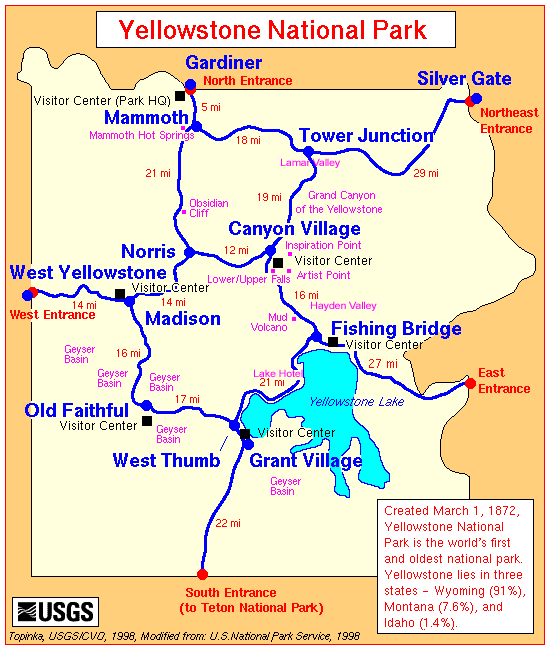

| This travelogue is one family's experience in Yellowstone. To see a photo in a 1024 x 681 size, just click on it. We hope you enjoy the record of our journey, and that you get to experience your own. Note: Stock photos of these and many other images with reproduction rights are available in their original 3008 x 2000 size. We also have a screen saver. Click here for more information. | |
| The Mud Volcano area is about 40 miles from the Upper Geyser Basin and is located just below the Hayden Valley a few miles above Lake Yellowstone. It is a series of mud pots and fumaroles on a hill. It's main claim to fame is that it is the smelliest area in the Park. We found it to be one of the most amazing as well. Click on the accompanying photo that tells the story of Mud Volcano, which is just one of the numerous mud pots in the area. |

|
| While the hot springs are typically beautiful aqua colors ringed by grounds of gold, the mud pots are angry caldrons of mud that bubble away. This shot of Mud Volcano shows its nastiness. What it cannot convey is the acrid smell of sulphuric acid that permeates the area. Microorganisms that live in the mudpots convert hydrogen sulphide gas from the magma chamber below the surface into sulphuric acid. |

|
| Just to the right of Mud Volcano is the colorfully-named Dragon's Mouth Spring. A large placque tells its story. |

|
| Dragon's Mouth Spring has steam boiling out from what looks like a small cave. |

|
| Picture of me at Dragon's Mouth Spring. |

|
| The view may look placid, but the Mud Volcano area houses a series of nasty, boiling caldrons of mud that have deforested much of the hillside, especially on the other side of the hill. While many of the trees still stand on this side, you can see a number that have already died and fallen down. |

|
| Here's a shot of the aptly-named Sour Lake, which is being poisoned by the foul water, which is also killing the forest in the area. |

|
| So much for the idea of bubbling spring waters. The run-off from Sour Lake is a ghastly green |

|
| The accompanying photo tells the story of Black Dragon's Caldron, whose name is now far more ominous than its actual image. |

|
| While its name is ferocious, Black Dragon's Caldron is now a relatively placid pool of mud. |

|
| While Black Dragon's Caldron is relatively placid, Churning Caldron looks ominous from a distance, as thick steam obscures everything nearby. |

|
|
"Double, double toil and trouble. Fire burn and caldron bubble." Shakespeare would have loved to see the toil and trouble inside Churning Caldron as it bubbles away -- and its getting hotter and stronger. In the early 1970s, the caldron was only about 110 degrees. After a series of earthquakes in the late 1970s, its temperature has risen steadily to the range of 190 degrees. |

|
| Mud geyser erupted every few hours in the late 1800s, but seemed to die in the late 1920s. After the earthquakes in the late 1970s, soil temperatures jumped substantially, killing all the trees in the area. |

|
| Click here to tour the Norris Geyser Basin.> |